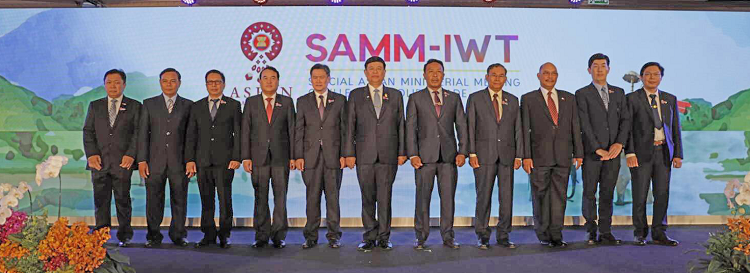ASEAN to Strengthen Efforts to Curb Illegal Wildlife Trade
Ministers from the 10 Association of Southeast Asian Nations (ASEAN) countries released a statement last week outlining the region’s commitment to strengthen efforts to address illegal wildlife trade and tackle wildlife crime.
Brunei Darussalam, Cambodia, Indonesia, Lao People’s Democratic Republic, Malaysia, Myanmar, Philippines, Singapore, Thailand, and Vietnam - the member states of ASEAN - issued the joint statement which describes illegal trade of wildlife as “among the greatest challenges of ASEAN as the economic, social and environmental repercussions are severe and widespread in scale.”
The ASEAN statement also commits member states to improving international co-operation as part of their combined efforts to meet obligations under the United Nations 2030 Agenda for Sustainable Development Goals (SDGs). One of the targets for SDG15, calls on countries to “Take urgent action to end poaching and trafficking of protected species of flora and fauna and address both demand and supply of illegal wildlife products.”
ASEAN has also vowed to ensure the successful implementation of the Plan of Action for ASEAN Cooperation on CITES and Wildlife Enforcement, 2016–2020. The commitment comes just weeks ahead of the 18th Conference of the Parties to the Convention on International Trade in Endangered Species of Wild Fauna and Flora (CITES), which will take place in Colombo, Sri Lanka this May.
Ivonne Higuero, Secretary-General of CITES commended Thailand as Chair and the ASEAN member states for their commitment to collaborative actions and called for “strong collaboration across source, transit and destination countries to ensure that criminal activities along the entire enforcement chain are addressed and neutralized from source to final destination.”
Figures for the scale of illegal wildlife trade worldwide vary: a 2012 WWF-commissioned report estimated its value as at least $19 billion per year, making it the fourth largest illegal global trade after narcotics, counterfeiting and human trafficking.
The Southeast Asia region functions as a source, transit and destination for a wide variety of trafficked wildlife products including elephant ivory, rhino horn, timber, pangolins, reptiles, tigers and songbirds.
“Despite the relentless pressure on natural resources, there are some positive signs of meaningful action in Southeast Asia, and it’s extremely encouraging to see that Thailand, in its capacity as overall chair of ASEAN for 2019, has chosen wildlife trafficking as a priority environmental issue,” said TRAFFIC's Director in Vietnam, Sarah Ferguson.

SDG15 Targets
By 2020, ensure the conservation, restoration and sustainable use of terrestrial and inland freshwater ecosystems and their services, in particular forests, wetlands, mountains and drylands, in line with obligations under international agreements.
By 2020, promote the implementation of sustainable management of all types of forests, halt deforestation, restore degraded forests and substantially increase afforestation and reforestation globally.
By 2030, combat desertification, restore degraded land and soil, including land affected by desertification, drought and floods, and strive to achieve a land degradation-neutral world.
By 2030, ensure the conservation of mountain ecosystems, including their biodiversity, in order to enhance their capacity to provide benefits that are essential for sustainable development.
Take urgent and significant action to reduce the degradation of natural habitats, halt the loss of biodiversity and, by 2020, protect and prevent the extinction of threatened species.
Promote fair and equitable sharing of the benefits arising from the utilization of genetic resources and promote appropriate access to such resources, as internationally agreed.
Take urgent action to end poaching and trafficking of protected species of flora and fauna and address both demand and supply of illegal wildlife products.
By 2020, introduce measures to prevent the introduction and significantly reduce the impact of invasive alien species on land and water ecosystems and control or eradicate the priority species.
By 2020, integrate ecosystem and biodiversity values into national and local planning, development processes, poverty reduction strategies and accounts.
Mobilize and significantly increase financial resources from all sources to conserve and sustainably use biodiversity and ecosystems.
Mobilize significant resources from all sources and at all levels to finance sustainable forest management and provide adequate incentives to developing countries to advance such management, including for conservation and reforestation.
Enhance global support for efforts to combat poaching and trafficking of protected species, including by increasing the capacity of local communities to pursue sustainable livelihood opportunities.
Facts and Figures
Around 1.6 billion people depend on forests for their livelihood. This includes some 70 million indigenous people.
Forests are home to more than 80 percent of all terrestrial species of animals, plants and insects.
2.6 billion people depend directly on agriculture, but 52 percent of the land used for agriculture is moderately or severely affected by soil degradation.
Due to drought and desertification each year 12 million hectares are lost (23 hectares per minute), where 20 million tons of grain could have been grown.
Over 80 percent of the human diet is provided by plants. Three cereal crops - rice, maize and wheat - provide 60 percent of energy intake.
